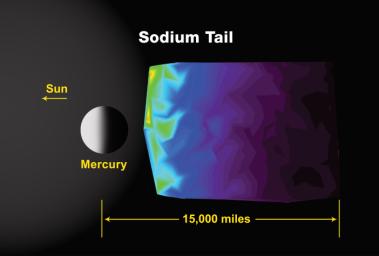
|
Mercury’s Sodium Tail
- Click the image above for a larger view
- Full-Res JPEG (3000 x 2025) (175.8 kB)
- Full-Res TIFF (3000 x 2025) (18.2 MB)
Caption:
This plot shows the intensity of emission of light associated with sodium atoms in the vicinity of Mercury. The observations were made with the Ultraviolet and Visible Spectrometer (UVVS) section of the Mercury Atmospheric and Surface Composition Spectrometer (MASCS). The intensity (up to 40 kiloRayleighs) indicates the relative abundance of material, in this case sodium atoms, along the observational line of sight back to the spacecraft. While sodium from Mercury has been observed with Earth-based telescopes, this is the highest-spatial-resolution image ever made. The geometry and observing circumstances have to be disentangled to infer the true spatial distribution, but the observations do confirm a north-south asymmetry that has previously been observed in ground-based sodium images.
The sodium emission is at 589 nm (in the visible part of the spectrum and the same wavelength, or color, as in sodium lamps and street lights on Earth). Because sodium atoms have intense emission, they are easy to detect, and this makes sodium a good tracer for other volatile elements in Mercury's exosphere.
Background Info:
These images are from MESSENGER, a NASA Discovery mission to conduct the first orbital study of the innermost planet, Mercury. For information regarding the use of images, see the MESSENGER image use policy .
Cataloging Keywords:
| Name | Value | Additional Values |
|---|---|---|
| Target | Mercury | |
| System | ||
| Target Type | Planet | |
| Mission | MESSENGER | |
| Instrument Host | MESSENGER | |
| Host Type | Orbiter | |
| Instrument | Mercury Atmospheric and Surface Composition Spectrometer (MASCS) | |
| Detector | ||
| Extra Keywords | Atmosphere, Color, Ultraviolet | |
| Acquisition Date | ||
| Release Date | 2008-01-30 | |
| Date in Caption | ||
| Image Credit | NASA/University of Colorado/Johns Hopkins University Applied Physics Laboratory/Carnegie Institution of Washington | |
| Source | photojournal.jpl.nasa.gov/catalog/PIA10396 | |
| Identifier | PIA10396 | |
